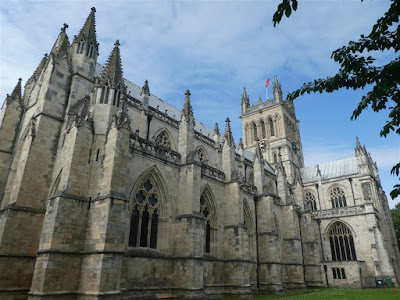Beverley, in the East Riding of Yorkshire, is graced by both four- and five-star parish churches. Beverly Minster had its origins in a monastery founded in the 8th century by St. John of Beverley. After he was canonized, in the 11th, a collegiate church came about, in part to accommodate pilgrims to his burial site. That church burned down in 1188, necessitating a new, grander collegiate church. This is the Minster that has come down to us today, another parish church of nearly cathedral dimensions, this time in very largely Decorated style (think: Flamboyant). There were many items of note, but the sculptural program within, particularly the images of musicians (Beverley apparently was a guild center for musicians), and a very rare Green Woman, interested us most.
 |
| Huge west window |
 |
| Nave |
 |
| Elevation |
 |
| Vaulting |
 |
| Snake charmer |
 |
| Let the music begin... |
 |
| Most of these along the north wall of the nave |
 |
| Beverley is sometimes the stunt-double for Westminster Abbey |
 |
| Largest and fanciest of all church gift shoppes we have seen; alas, closed on Sundays |
 |
| Helpful floor plan |
 |
| In chancel |
 |
| More beautiful carving in the quire; including 68 misericords |
 |
| Thus |
 |
| More music |
 |
| Abaft the beam |
 |
| Our Founder |
 |
| Green Man |
 |
| Green Woman; extraordinarily rare |
 |
| And the band played on |
 |
| Decorated... |
 |
| We did the Sunday carvery here; not memorable |

















































